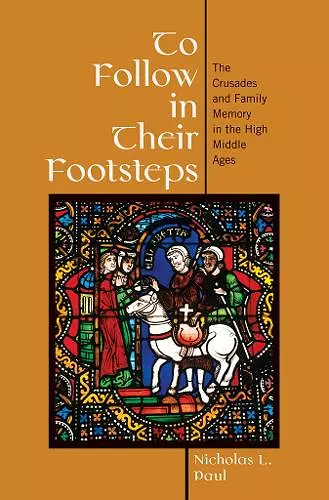To Follow in Their Footsteps
The Crusades and Family Memory in the High Middle Ages
Format:Paperback
Publisher:Cornell University Press
Published:15th Oct '17
Should be back in stock very soon

When the First Crusade ended with the conquest of Jerusalem in 1099, jubilant crusaders returned home to Europe bringing with them stories, sacred relics, and other memorabilia, including banners, jewelry, and weapons. In the ensuing decades, the memory of the crusaders' bravery and pious sacrifice was invoked widely among the noble families of western Christendom. Popes preaching future crusades would count on these very same families for financing, leadership, and for the willing warriors who would lay down their lives on the battlefield. Despite the great risks and financial hardships associated with crusading, descendants of those who suffered and died on crusade would continue to take the cross, in some cases over several generations. Indeed, as Nicholas L. Paul reveals in To Follow in Their Footsteps, crusading was very much a family affair.Scholars of the crusades have long pointed to the importance of dynastic tradition and ties of kinship in the crusading movement but have failed to address more fundamental questions about the operation of these social processes. What is a "family tradition"? How are such traditions constructed and maintained, and by whom? How did crusading families confront the loss of their kin in distant lands? Making creative use of Latin dynastic narratives as well as vernacular literature, personal possessions and art objects, and architecture from across western Europe, Paul shows how traditions of crusading were established and reinforced in the collective memories of noble families throughout the twelfth and thirteenth centuries. Even rulers who never fulfilled crusading vows found their political lives dominated and, in some ways, directed by the memory of their crusading ancestors. Filled with unique insights and careful analysis, To Follow in Their Footsteps reveals the lasting impact of the crusades, beyond the expeditions themselves, on the formation of dynastic identity and the culture of the medieval European nobility.
[To Follow in Their Footsteps] is a stimulating contribution to each of the two subjects it covers. Its publication should mark a new phase in critical discussion about how the crusades were interpreted in the middle ages.
* The English Historical Review *[Paul] weaves a history of the texts produced about crusader families into an analytic framework that draws on the insights of anthropology, literary theory, and sociology. Eschewing the more traditional positivist reading of crusade chronicles and family histories, Paul lays bare the various and variegated components of these texts, highlighting the role of women, objects, orality, romance, ritual, and liturgy in the collective articulation of dynastic memory. To Follow in Their Footsteps marks a critical moment in the creation of a new cultural history of crusading.
* Speculum *A prominent example (of many) from Medieval Europe of how past generations were invoked to mould the actions of their successors is supplied by the crusades. As Nicholas Paul puts it in this lively new account, crusading was always a family matter. And by family he means the dead as wll as the quick.... In the first part of the book, Paul provides a splendidly informative, illuminating and often entertaining description and analysis of what, how and where ancestral voices could have been heard by putative crusaders in the twelfth century.
* Times Literary Supplement *Paul showcases examples of two effective monarchs constantly exhorted to crusade, Henry II of England and Alfonso II of Aragon. For all the literary energy expended trying to persuade them, neither actually went, although their sons did. In the end, Paul suggests noble memory kept the idea of the crusade alive long after it had been laid to rest by governments and Christian society. Summing Up: Recommended.
* Choice *Paul's book is an important contribution to crusading scholarship inthat it expands the current scholarship on memory and commemoration.An added strength of this work lies in the variety of themes undertaken.This is a compelling work that opens the way for further scholarship andmethodologies on many aspects of crusading, not least of all the ways inwhich texts and objects intersected with individuals and families to providemeaning and context to the early crusaders.
-- Kathryn Smithies * Parergon - Journal of the Australian and New Zealand Association for Medieval and Early Modern Studies *The real achievement of this book is not so much that it is the 'last word' on aristocrats and the Crusades. Rather, in the sheer variety of the themes that it tackles, it broadens scope for discussion of this crucial issue. Paul's book may well follow in Marcus Bull's footsteps, and set the agenda for the 'next generation' of investigation into the topic. That is no mean achievement for the author's first book.
* Reviews in History *The result is a very thoughtful and thought-provoking study of the impulses, dynamics and mechanisms involved in the shaping of medieval social memories and identities, and the long-term impact of the crusades on Europe's collective memory and culture. It is by all measures an intensely meticulous piece of research, presented by the author in an engaging way. Those inspired to delve deeper into the 'memories' of the many families and individuals introduced throughout the chapters will be greatly helped by the book's four appendices.
-- Jochen Schenk, University of Glasgow * History: Journal of the Historical Associati- Winner of Cowinner of the John Nicholas Brown Prize (Medieva.
ISBN: 9781501710643
Dimensions: 235mm x 155mm x 21mm
Weight: 907g
368 pages